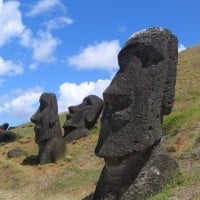Top 10 Interesting Facts About Easter Island
Easter Island, also known as Rapa Nui, is a secluded yet inhabited island located in the South Pacific Ocean. It is filled with beauty, both in terms of the geography and the iconic Moai statues present on the island. Besides its beauty, the island is filled with wonder; there are many mysteries surrounding it, especially regarding its history, geography, and the Moai statues. Without further ado, here are some facts related to Easter Island or Rapa Nui.
Believe it or not, the islanders were able to move these heavy and tall statues about 11 miles across the island without the use of wheels or massive animals. However, how they accomplished this feat remains unknown. Scientists theorize that the people moved them with the use of ropes, log rollers, and wooden sledges.
While it is noticeable today that Easter Island is virtually free of trees, it once had a forest of palm trees. However, due to acts of deforestation, the island is no longer the palm-tree-forested land it once was. This was primarily due to the cutting of trees for material to be used for homes, canoes, and logs to transport the Moai statues, as well as the Polynesian Rats that consumed palm tree seeds, making it difficult for new trees to regrow.
The original name of Easter Island was Rapa Nui, which means "Great Rapa." Then, Dutch explorer Jacob Roggeveen arrived on the island, becoming the first European to ever set foot on it. Because he arrived on April 5, 1722, which was Easter Sunday, this led to the island earning the name "Easter Island."
The nearest inhabited island is Pitcairn Island, which has a population of nearly 500 people, and is over 1,200 miles away. On the other hand, the closest place on the mainland is none other than the country of Chile, which is nearly 2,200 miles away.
While it may appear that Moai statues are simply heads - hence the name "Easter Island Head" - the statues are actually quite larger than we think. The Moai statues have bodies, but many of them are buried up to their shoulders, revealing only their heads.
The Moais have their whole bodies underground, except for the heads. The population of the island is close to 10,000. Unlike Pitcairn, there are not fewer people living on it.
It is believed that the statues were built by the people of Rapa Nui in honor of their ancestors. They were also built to represent powerful ancestral spirits, whom the people believed brought protection and blessings to the community.
The primary material the islanders used to carve the statues was volcanic tuff from the quarry of Rano Raraku, an extinct volcanic crater. The material is generally soft, making it easy enough to carve.
There are about 887 Moai statues on Easter Island. It is quite impressive that this number of giant statues was built on such a small island.
The peak population of Easter Island was estimated to be nearly 17,500 people. However, when British explorer James Cook arrived in 1774, he estimated the population to be around 700 people. There isn't a definitive reason as to why the population drastically dropped, but it is possible that this was due to the depletion of resources on the island.
While there are a few exceptions, most of the Moai statues face away from the ocean. This was possibly because the Moai statues were meant to watch over the community.